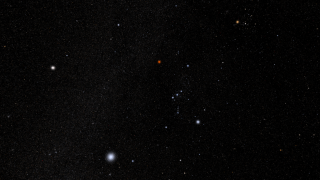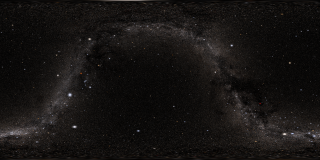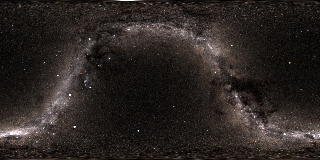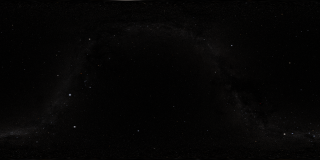The Tycho Catalog Skymap
|
This image set is a skymap of stars from the Tycho and Hipparcos star catalogs. The maps are plotted in plate carrée projection (Cylindrical-Equidistant) using celestial coordinates making them suitable for mapping onto spheres in many popular animation programs. The stars are plotted as gaussian point-spread functions (PSF) so the size and amplitude of the stars corresponds to their relative intensity. The stars are also elongated in Right Ascension (celestial longitude) based on declination (celestial latitude) so stars in the polar regions will still be round when projected on a sphere. Stars fainter than the threshold magnitude, usually selected as 5th magnitude, have their magnitude-intensity curve adjusted so they appear brighter than they really are. This makes the band of the Milky Way more visible. Stellar colors are assigned based on B and V magnitudes (B and V are stellar magnitudes measured through different filters). If Tycho B and V magnitudes are unavailable, Johnson B and V magnitudes are used instead. From these, an effective stellar temperature is derived using the algorithms described in Flower (ApJ 469, 355 1996). Corrections were noted from Siobahn Morgan (UNI). The effective temperature was then converted to CIE tristimulus X,Y,Z triples assuming a black-body emission distribution. The X,Y,Z values are then converted to red-green-blue color pixels. About 2.4 million stars are plotted, but many may be below the pixel intensity resolution. The three most conspicuously missing objects on these maps are the Andromeda galaxy (M31) and the two Magellanic Clouds. [The images in this visualization were updated August 28, 2007 to fix a bug in the star generation algorithm.]
|
|

|
|
This movie is a sample tour of the skymap. It starts looking at the North Celestial Pole (the Little Dipper is visible). We then make short trips to the Big Dipper, the Summer Triangle (Cygnus, Lyra, and Aquila), the Orion and Taurus region, southward to Canis Major, and over to Scorpius and Saggitarius. The movie ends pointed at the South Celestial Pole (the Southern Cross is visible to the right).
Duration: 1.1 minutes
Available formats:
1280x720 (30 fps)
Frames
1280x720 (30 fps)
MPEG-2
109 MB
640x360 (30 fps)
MPEG-4
78 MB
1280x720 (30 fps)
MPEG-4
237 MB
320x180
PNG
288 KB
160x80
PNG
62 KB
80x40
PNG
15 KB
512x288 (30 fps)
MPEG-1
25 MB
How to play our movies
|
|

|
|
A low-resolution version of the skymap. The threshold magnitude is 5.0 so the Milky Way is very bright and bright stars are large.
Available formats:
4096 x 2048
TIFF
24 MB
320 x 160
PNG
263 KB
|
|

|
|
A low-resolution version of the skymap. The threshold magnitude is 4.0 so the Milky Way is fainter and bright stars are smaller than the map above.
Available formats:
4096 x 2048
TIFF
24 MB
320 x 160
PNG
252 KB
|
|

|
|
A low-resolution version of the skymap. The threshold magnitude is 3.0 so the Milky Way is very faint.
Available formats:
4096 x 2048
TIFF
24 MB
320 x 160
PNG
241 KB
|
|

|
|
These are high-resolution versions of the skymaps. They are best suited for use when you need a small field-of-view and don't want bright stars to overpower the image.
Available formats:
8192 x 4096
TIFF
96 MB
16384 x 8192
TIFF
384 MB
320 x 160
PNG
237 KB
|
| Animation Number: | 3442 |
| Animator: | Tom Bridgman (SVS) (Lead) |
| Completed: | 2007-08-14 |
| Data set: | Hipparcos and Tycho Star Catalogues |
| Data Collected: | November 1989 - March 1993 |
Keywords:
SVS
>> HDTV
SVS
>> Milky Way
SVS
>> Sky Map
SVS
>> Stars
|
|
Please give credit for this item to
NASA/Goddard Space Flight Center Scientific Visualization Studio |
|
Back to Top
|